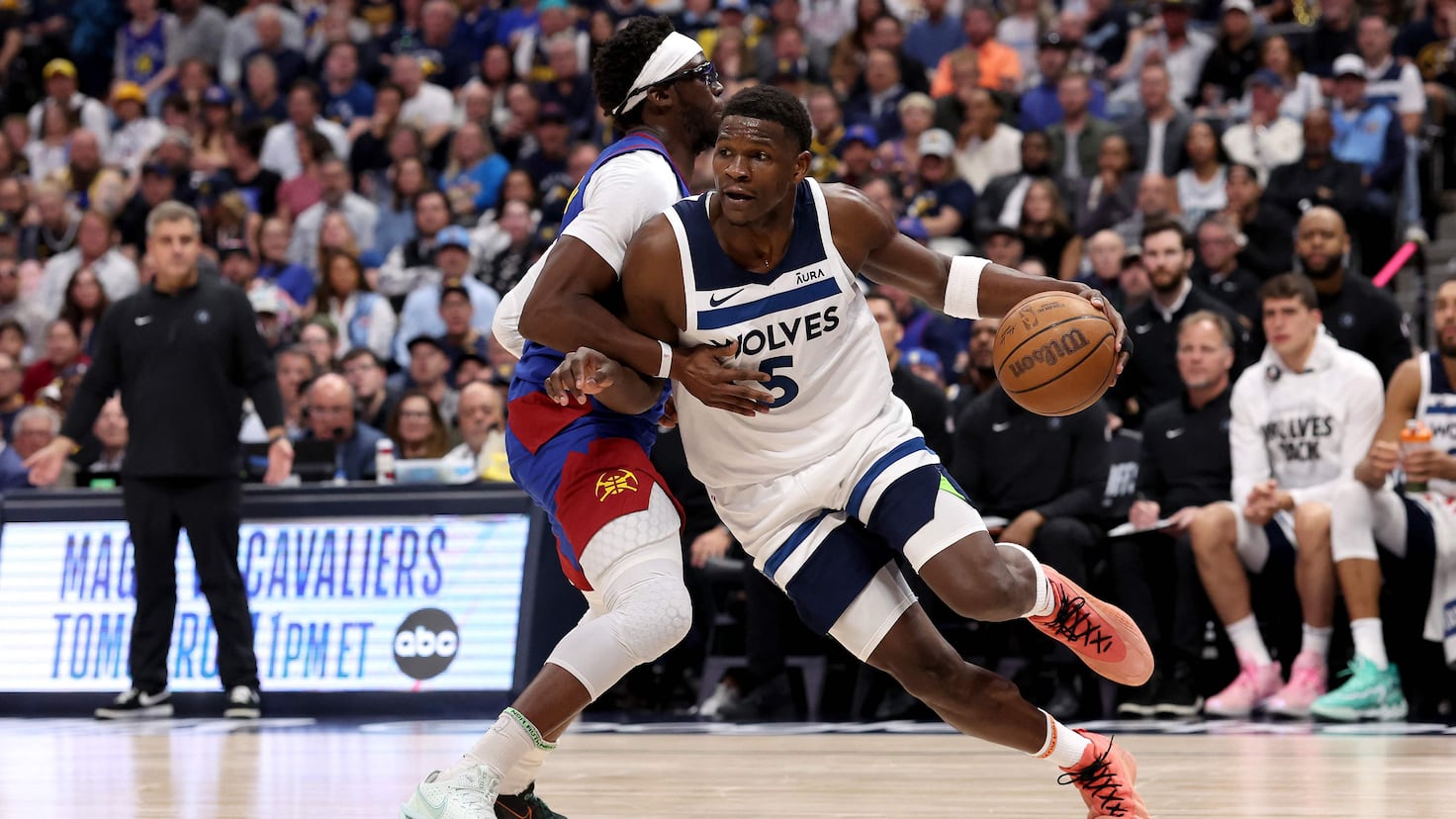Denver, CO
Broncos new uniforms mostly a win

Well, Broncos Country, what do you think?
The wait for new uniforms is officially over. The colors remain largely the same (the navy blue may actually be darker or just look that way) and the logos are untouched. The color combinations will take some time to get used to. Some are much better than others.
Marking the Broncos’ first major uniform change since 1997, the Mile High Collection integrates elements of the Colorado landscape throughout the jerseys, helmets and pants while offering nine primary uniform combinations. The new set features the Broncos’ current logo and colors—Sunset Orange (home), Summit White (away) and Midnight Navy (alternate)—along with metallic satin helmets in navy (home/away) and white (alternate).
The white helmet is a total homerun. First introduced last year with the classic ‘D’ logo, it’s hard to believe that it looks even better with the current horse head logo. The sleeves are thoughtful in integrating the jawline of the horse logo as well as calling back to the sleeve design of the mid-60’s uniforms.
Then there are the triangles and the elevation of the 5280’ to the uniform. It’s going to take a bit to get the fanbase to embrace the triangle-life. Fears of the 5280’ on the pants, jersey, and helmet were misplaced. All elements of the uniform integrate it in solid ways.
Gone on the helmet is the solid orange stripe that diminished as it goes from back to front. In it’s place are more triangles (meh). It’s a cleaner look for the helmet for sure. The 5280’ on the front is a great addition.
Immediately following the release of the new uniforms was the unveiling of the throwback uniforms. As expected, they are as amazing today as they were back in the day. It’s going to be awesome seeing these on the field once again.
The collection also introduces the highly anticipated throwback orange uniform that includes the iconic Legacy Blue ‘D’ helmet, playing tribute to the Orange Crush era and the Broncos’ first Super Bowl appearance in 1977. Including the throwback closet, the Mile High Collection features a total of 10 uniform combinations, four jerseys and three helmets to demonstrate the versatility of the Broncos’ new look.
As someone who remembers when the Denver Broncos played in these every week, it’s a picture like this that reminds you of just how big the pads were back in the day.
So, there you have it, Broncos Country! These are your new uniforms for better or worse. I think the Broncos came out ahead on these. The throwbacks are a huge win and the new uniforms aren’t so bad that I’m throwing things.
Give me any player(s) worthy and I’m buying soooooo many jerseys this week.
— Mike DeCicco (@MikeDeCicco) April 22, 2024
Now all we need is some players to wear these jerseys! On to the draft and the 2024 season!

Denver, CO
Timberwolves 106 – 99 Nuggets summary, stats, scores and highlights | NBA Game 1

Joker in is comfort zone
For as good as Nikola Jokic is in the regular season, he is even better in the playoffs. He has the luxury of having fantastic players around him, but that is in large part because of how easy the Serbian makes the game. Taking nothing away from Aaron Gordon, or Michael Porter Jr. or Kentavious Caldwell-Pope are are great players, but they are better players when Nikola Jokic is on the court. In the first round, he averaged 28.2 points, 16.2 rebound and 9.8 assists to lead the NBA in each category though one round. Against Minnesota, he is going to be going up against a two time Defensive Player of the Year, Karl-Anthony Towns, and Naz Reid as second and third defensive options.
Denver, CO
LetsGoDU: Denver Women’s Lacrosse Stifles Furious UConn Comeback Bid to Earn BIG EAST Tournament Title

10th ranked/#1 seed Denver (15-3, 6-0) capped an undefeated BIG EAST regular season by winning the BIG EAST Tournament against #2 seed UConn,16-14. DU built a 9-1 lead but had to withstand a 4th-quarter tie with the Huskies to escape with the win and the BIG EAST title.
Denver reeled off five straight goals to open the first quarter of play. Caroline Colimore and Sloane Kipp scored for Denver in the first two minutes to race out to a quick lead. Julia Gilbert took a feed from Kipp to keep the run going at 10:33. Four minutes later, Olivia Ripple found the back of the net for the Pioneers. Kipp Sloane finished off the first-quarter scoring outburst in the final two minutes to build a 5-0 lead.
Denver followed the same recipe to start the second quarter when Ryan Dineen scored in the first minute. UConn’s Susan Lafountain finally broke the ice at 11:43 to temporarily stop the DU run. Denver responded with three straight goals by three different Pioneers – Jane Early, Gilbert and Kyra Obert to build a 9-1 lead. Denver was coasting to the title, right? Wrong. In the final 5:11 before halftime, the Huskies woke up with three goals of their own by Kate Shaffer (free position), Shaffer again (man-up) and Madelyn George. The Huskies were chipping away at the massive deficit.
The teams traded goals in the third quarter with both scoring four goals. Denver opened the scoring three minutes into the period when Julia Gilbert found paydirt. UConn scored two minutes later but DU’s Jane Early responded to retain the five-goal edge, 10-5. UConn scored again at 7:13 but Caroline Colimore responded a minute later with a DU tally. Denver countered another Husky goal when Jane Early scored after a Denver draw control and feed a half minute after the UConn goal. Under a minute to go in the third period, the Huskies Kate Shaffer scored to draw within five goals, 13-8.
Denver looked to be on cruise control heading into the final 15 minutes but UConn had other ideas. UConn started to chip away at DU’s five-goal lead. Abby Charron scored in the first minute to start the ball rolling for UConn. Less than a minute later, Caroline Colimore scored for Denver to regain the 5-goal margin. The Huskies then reeled off two straight goals at 10:16 and 9:16 to cut DU’s advantage to three goals as UConn started to gain momentum and confidence. In the final five minutes, the Huskies buried three more goals, a five-goal run in all, to knot the score 14-14. With under two minutes to go, Denver forced a turnover and called a timeout. The ball went into Ryan Dineen with a feed to Julia Gilbert who buried the shot, 15-14, with a minute to go. Gilbert, the hero of the game for DU, secured the draw control as DU took fouls and ran clock. Colimore added the icing on the cake with a goal as time expired for a final score 16-14.
DENVER SURVIVES. 😬@DU_WLAX scores twice in the final minute after @UConnWLAX pulled all the way back.
DENVER WINS THE @BIGEAST. pic.twitter.com/zB7UinIYNp
— USA Lacrosse Magazine (@USALacrosseMag) May 4, 2024
DU outshot the Huskies 28-18 along with only 7 turnovers to 17 for the Huskies. However, UConn was efficient in the offensive zone to make it a game. Colimore and Gilbert had four goals each. Sloane Kipp had two goals and six assists. Kate Shaffer had five goals and three assists to pace the Huskies.
The NCAA selection show is on Sunday at 7:00 pm MT when Denver will learn their NCAA seeding and opponent.
Denver, CO
It was already tough, but a jump in mortgage rates and higher home prices are making it even harder to buy a home in metro Denver.

Builders are finally making a dent in the state’s housing shortfall, especially for apartments. But home prices and mortgage rates continue to outpace income gains, and affordability is worsening rather than improving.
“The story with interest rates is that they are only exacerbating the problem,” said Steven Byers, chief economist with the Common Sense Institute in Denver. “The fact is that wages aren’t keeping up with these huge jumps in home prices.”
For the first time since July 2022, home prices in all major U.S. metros, including Denver, rose year-over-year, reports brokerage firm Redfin. The S&P CoreLogic Case-Shiller Index for Denver has home prices up 2.7% the past year through February.
After five weeks of increases, the average interest rate charged on a 30-year loan reached 7.22%, the highest level since Thanksgiving, according to Freddie Mac.
Purchasing a home was hard before, and it is only getting harder. In 2011, a buyer in Colorado could expect to work 44 hours a month on average to cover the mortgage payment. That bar moved up to 96 hours last year, a 118% increase, according to CSI’s Colorado Housing Competitiveness Index, which Byers co-authored.
Things are only slightly better for renters. They had to work 45 hours on average to cover the monthly rent in 2011. Now they have to work 87 hours. Colorado tenants devote more hours of work a month to meet the rent than do residents of any other state, according to the CSI report.
After the Great Recession, metro Denver became a hot spot for young professionals and tech workers looking to relocate. Demand for housing outstripped supply, causing home prices and rents to rise. Net domestic migration has fallen the past two years, as more people pick up and leave and fewer move in, Byers said. Higher housing costs have made the state less attractive.
That is both good and bad. Slower population growth should reduce pressure on the housing market and give builders time to catch up, stabilizing home prices and rents over time. But it also leaves employers and the larger economy, long dependent on importing the talent it needs, vulnerable. If the economy stalls, those struggling with higher living costs could pay the price.
Of the 50 largest U.S. metro areas, only six have median home prices that align with median incomes, according to a study from Clever Real Estate. Denver had the 8th biggest gap between in the amount of income needed to attain a median-priced home.
Zillow places the typical home value in metro Denver at just shy of $561,000 in December. Assuming a 20% downpayment and at current mortgage rates, an annual income of $167,562 would be required to buy that home, according to the Clever Real Estate study.
But here’s where it gets painful. The median income for metro Denver households is $98,975 a year, resulting in a shortfall of $68,587. Denver residents earn above-average incomes, but the higher pay isn’t enough to cover way above-average housing costs.
Wages tend to be lower in other parts of the state, and the affordability “gap” statewide is a little larger at $69,587. Colorado’s median home price is $531,900, not too far behind the metro Denver median price. With 20% down, that requires an income of $158,889, according to Clever Real Estate. The median household income statewide is $89,302.
Absent outside help, first-time buyers are often hard-pressed to put 20% down. That would require $112,200 on the typical home in Denver. What could someone putting 10% down and making the median income in Denver afford after the recent jump in mortgage rates? Clever Real Estate puts that amount closer to $270,000 to $280,000.
Good luck finding that. Out of 6,458 single-family home closings in metro Denver in the first three months of the year, only 50 involved a home priced below $300,000, according to the Denver Metro Association of Realtors.
Buyers of condos and townhomes face better odds, with 452 out of 2,343 sales this year below $300,000. But even there, only 20% of listings are affordable to households earning a median income. Only 5.7% of sales, homes or condos, were attainable.
The hurdle is even higher for new home buyers. The median new home price in Colorado is about $650,000, according to a study from the National Association of Homebuilders. Only one in five households in the state can afford something at that price point. Two million households in the state can’t afford to purchase a new home at the middle price point.
Renting cheaper now, but costly long-term
Most renters have limited options when it comes to buying in metro Denver. But in their favor, renting offers a substantial discount over buying right now, according to a separate analysis from Bankrate, the personal finance website.
The typical monthly payment for the median-priced home is around $3,627 in metro Denver, including the mortgage payment, property taxes and insurance. By contrast, the typical rent is $2,027 when looking at a rent index from Zillow that combines apartment, condo and home rents.
Renting was cheaper than buying in all 50 metros studied, but Denver had the ninth largest gap at $1,600. That 79% premium was much larger than the 36.6% premium to own nationally.
“I wouldn’t say rent is affordable, but between buying and renting, renting is the lesser of the two evils,” said Alex Gailey, lead data reporter at Bankrate and the author of the analysis.
In an ideal world, renters would sock away that extra money as emergency savings. After that, savings would be invested in the stock market, which has provided a higher return than owning a home over time. If an employer matches a retirement plan contribution, that would translate into an automatic 50% return off the bat.
But most renters probably won’t follow that strategy, leaving them vulnerable long-term, Gailey acknowledges. If an area isn’t losing population, homes should rise in value even after accounting for repairs and maintenance.
That equity can be poured into buying a bigger home down the road, or it can help fund expenses in retirement or be passed onto children and heirs, building inter-generational wealth. Also, mortgage payments can be locked in, while a rent payment can’t.
“You are building equity for yourself rather than for someone else,” said Jen Ankrum, director of sales for KB Home in Colorado, when asked about the message the company shares with renters looking to buy.
First-time buyers account for about half of the sales at KB Home, which strives to provide a high-quality, energy-efficient home priced below the competition. Even with the heavy focus on first-timers, about a third of buyers make under $100,000, a third make $100,000 to $150,000 and a third make more than that amount.
Normally, the housing market tries to find an equilibrium, offsetting rising interest costs with slower price gains or even price declines. But demographics have prevented that from happening. Millennials, born between 1981 and 1996, are now the nation’s largest generation at 72 million. They are behind schedule compared to prior generations when it comes to buying homes and pushing hard to acquire them even if the conditions aren’t favorable.
Markets where more millennials relocated to have housing markets under the most pressure. A little more than six in 10 homebuyers in metro Denver are millennials — only San Francisco and San Jose in California and Boston have a higher share of millennial buyers, according to a study from loan portal LendingTree.
None of those markets would be considered affordable. In Denver, millennial buyers on average made a downpayment of $70,710 and borrowed $456,805 to purchase a home, LendingTree reports.
“A big reason why millennials concentrate in expensive housing markets is because those areas often have robust and relatively high-paying job markets,” said Jacob Channel, a senior economist at LendingTree and author of the report.
Large tech companies are reducing their headcounts and a recession, when it comes, could accelerate layoffs. What happens if those high-paying jobs go away but the high mortgage payments don’t? But Channel doesn’t see a systemic risk to the housing market.
“While there are doubtlessly some millennials who are currently stretched too thin and must contend with the prospect of downsizing or, in the worst case, foreclosure, the number of people struggling isn’t large enough for there to be a serious risk to the broader housing market,” Channel said.
Get more real estate and business news by signing up for our weekly newsletter, On the Block.
-

 News1 week ago
News1 week agoLarry Webb’s deathbed confession solves 2000 cold case murder of Susan and Natasha Carter, 10, whose remains were found hours after he died
-

 News1 week ago
News1 week agoFirst cargo ship passes through new channel since Baltimore bridge collapse
-

 World1 week ago
World1 week agoHaiti Prime Minister Ariel Henry resigns, transitional council takes power
-

 World1 week ago
World1 week agoSpanish PM Pedro Sanchez suspends public duties to 'reflect'
-

 World1 week ago
World1 week agoUS secretly sent long-range ATACMS weapons to Ukraine
-

 News1 week ago
News1 week agoAmerican Airlines passenger alleges discrimination over use of first-class restroom
-

 Education1 week ago
Education1 week agoVideo: Johnson Condemns Pro-Palestinian Protests at Columbia University
-

 Movie Reviews1 week ago
Movie Reviews1 week agoAbigail Movie Review: When pirouettes turn perilous



















